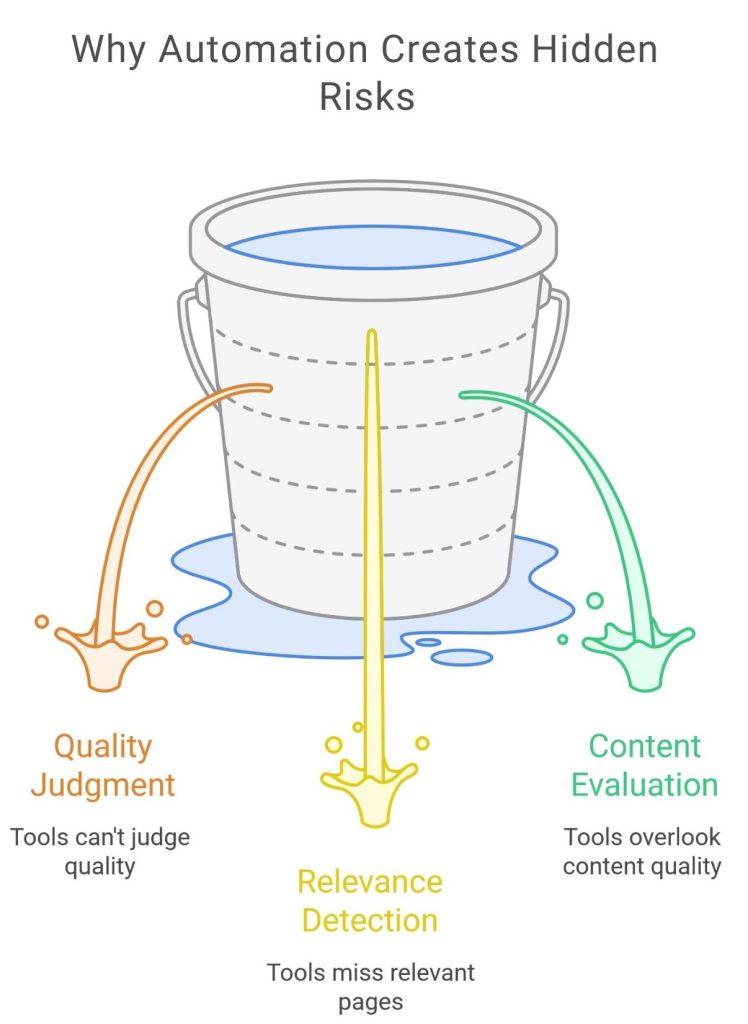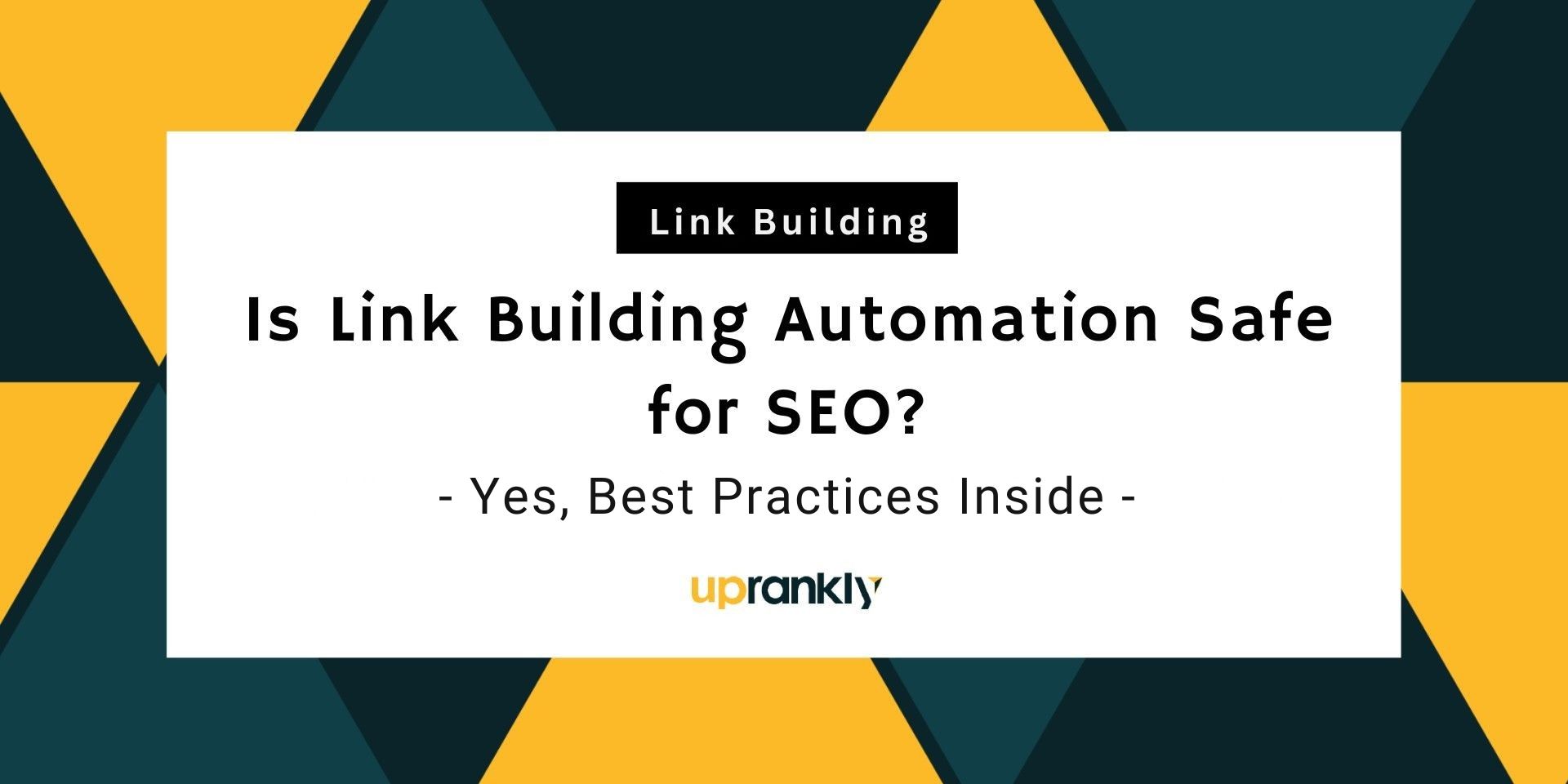8 Link Building Automation Risks & How to Avoid Them
Link building automation risks include Google penalties, sender reputation damage, weak blogger relationships, spam signals, etc.
The solution?
You can avoid them by vetting the prospects, personalizing blogger outreach emails, and checking relevance while using link building automation tools for tasks like filtering prospects, scheduling outreach, etc.
Key Takeaways
- Automation lacks identifying relevance and context that harm link safety.
- Ensure manual checks like vetting prospects, email personalization, link reviews, and final approvals.
- AI improves workflow speed by reducing research time by 81% and automating 70% of outreach steps, which raises follow-up success rates by 17%.
The goal of this Uprankly guide is to explain link-building automation risks, show where automation fits, and clarify which tasks need human control for safe SEO results.
Table of Contents
ToggleWhat Link Building Automation Means
Link building automation means using tools to automate repetitive tasks of the backlink-acquiring process, like identifying and vetting prospects, sending outreach emails, and tracking campaign performance.
A link-building tool streamlines these repetitive tasks, increasing the productivity of a link builder. Thus, the professional can focus on a building strategy instead of doing manual work.
These tools help a link builder or SEO professional find high-quality, verified, and authoritative sites without hard work. Moreover, you can filter the SEO metrics like Domain Authority, traffic, and check the relevance during the vetting process.
Also, sending blogger outreach emails and follow-ups becomes easier with these tools. At the same time, adjusting the strategy according to the campaign performance allows you to get the most out of the link-building tactics.
Overall, automation gives scale while human interaction protects accuracy. It is reported that a link-building automation tool can cut down the process time from over four hours to 30 minutes.
Why Automation Creates Hidden Risks

Automation creates hidden risks if you choose a low-quality and irrelevant site to create a backlink for your website.
In this case, you must vet the websites manually. Relying on automation can hamper your website’s reputation. More importantly, unnatural links at scale can violate search engine guidelines and result in severe penalties.
- Limits of Fully Automated Link Building
Fully automated link building creates hidden risks because automation tools cannot judge quality the way humans do.
The automated system will give you the prospect lists, while the tools can’t find the difference between a relevant and irrelevant page based on your niche.
As a result, the tool fails to choose the correct website to create a backlink. Here, your involvement is crucial to protect relevance and fit, which leads to safer and more relevant links.
Moreover, a tool may flag a site as strong, yet the content might not match your topic or audience. When automation runs without checks, you may reach out to link sources that look fine on the surface but fail to support long-term goals. A small human step fixes that gap.
- Gaps That Tools Often Miss
Automation tools create hidden risks as they look at numbers, not meaning, leading to missing key signals like relevance.
Tools can scan authority data, but they cannot sense if a page feels current, helpful, or aligned with your niche. Remember that search engines look for relevance, and that point is easy to miss when a tool ranks pages only by metrics.
Furthermore, automation can overlook signs like thin content, outdated advice, or unnatural anchor use. These minor issues shape how search engines judge link sources. A quick human check finds these gaps and keeps your outreach on the right path.
What are Key Link Building Automation Risks?

The key link-building automation risks involve weak quality control, poor personalization, and patterns that search engines treat as unsafe.
Automation improves productivity, yet it often ignores signals that require your judgment.
Many tools collect sites without a deep review, so low-quality domains enter the process. These AIs also repeat the same pitch across large lists, and bloggers reject messages that feel copied.
In fact, automation can create unnatural patterns when the links come from unrelated pages or weak sources. These issues harm trust and lower the value of the Backlink Profile.
Strong results need careful checks, natural outreach, and steady human input at the right stages.
Here are the key 8 risks of AI link building that need to be considered.
Google Penalties
Google penalties become a real risk when link building automation replaces human oversight.
Tools fail to choose link sources that look safe on the surface but carry patterns that search engines dislike.
Even a few tools provide cheap backlink sources or Private Blog Networks. These sites create toxic backlinks that harm a Link Profile.
Search engines track patterns, and low-quality links look unsafe. When automation moves bad sites into outreach, the links that follow increase the chance of a penalty.
Spammy Outreach and Template Fatigue
Blogger outreach tools often feel repetitive because they rely on rigid email templates. Influencers or bloggers notice the lack of personal touch, and they stop responding.
Moreover, some tools add weak referring domains into the list, which reduces trust even more. Furthermore, emails that sound identical across many sites lose their impact fast. Additionally, cheap backlink sources rarely reply to copied messages, so the Backlink Profile gains little value.
As a result, the overall outreach begins to look careless, and online visibility drops as replies slow. A campaign filled with generic content struggles to earn steady results.
Sender Reputation Damage
Email platforms like Google and Outlook measure patterns closely, and sudden spikes from automated outreach raise concerns. Large bursts signal risk, and messages may land in spam.
Also, repeated use of outdated email templates increases the number of filters that block the message. Remember that editors never see the pitch when the sender’s score falls.
Strong referring domains avoid accounts with poor trust signals, so high-quality links become harder to earn.
Lost deliverability also affects future campaigns, and online visibility suffers. A damaged reputation takes time to repair, and results are slow across every project.
Links From Questionable Sites
Automated backlinking software often collects domains that look fine on the surface but fail deeper checks.
Cheap backlink lists slip into the workflow because most tools only review basic SEO metrics. Private Blog Networks appear as normal websites, yet they carry toxic backlinks.
Also, low Page Authority pages bring no referral traffic, and the Link Profile weakens.
Some domains hide inflated numbers that make them seem legitimate, but they add no real value. A steady flow of questionable sites harms website authority over time.
Weak Personalization Ruins Blogger Relationships
Weak personalization becomes a significant risk when link-building automation sends the same pitch to every blogger.
Bloggers expect a note that shows you visited their site, understood the topic, and respected their work. Automated outreach fails those details, and the relationship breaks before it starts.
Poor personalization also lowers reply rates because the message does not match the blogger’s style or audience.
A cold, generic email damages trust, and the long-term value of the outreach drops. Blogger relationships need clear human attention to stay strong.
Reporting Gaps and Tracking Errors Slow Progress
Tracking changes in the Backlink Profile is crucial. Some tools cannot detect removed or altered links, and those issues go unnoticed.
As a result, link juice fades out without warning, and the broken pages’ website exists because the scan was never reviewed again.
Drops in referring domains stay hidden, and performance tracking loses accuracy.
Overall, poor website broken link checking creates confusion and slows progress across every campaign.
Wasted Resources and Costly Recovery
Some automated link-building tools add sites that do not have verified contact emails, and that creates a clear risk.
When the list includes domains with invalidated addresses, the outreach never reaches a real inbox. Emails bounce, replies stop, and the campaign loses momentum.
Thus, money disappears into tools that produce weak results.
In addition, cheap backlink sources add toxic link profiles that demand cleanup later. Recovery becomes expensive when website authority drops.
Such extra work drains the budget, and progress stalls while the link-building team repairs earlier mistakes. A series of poor choices creates long cycles of wasted effort.
Ineffective and Short-lived Results
Automated link building often creates links that look helpful at first but lose value quickly.
- Low Page Authority sites drop fast in search engines, and the benefit disappears.
- Thin content pages bring no referral traffic, so the link adds nothing meaningful.
- Weak domains fail to support long-term online visibility, and rankings slip.
- Poor sources also reduce the strength of the Link Profile over time.
Short-lived results force frequent rebuilding, and the cycle drains both time and energy. All in all, campaigns lose momentum when links cannot hold steady value.
What are the Safe Ways to Use Link Building Automation?
The safe way to use link building automation is to give automation only the tasks such as creating prospect lists, scheduling and following up emails, tracking campaign performance, monitoring backlinks 24/7, filtering and organizing the list, etc.
Also, it would be best if you vet the prospects, personalize the email, check anchor texts, and get final link approvals from clients.
Here is what you need to do to ensure your link-building campaign is safe.
Automate Only the Low Risk Steps
Safe use of link building automation starts by limiting the automated process to tasks that carry low risk.
Automated solutions work well for simple actions like
- Finding prospects
- Collecting SEO metrics
- Validating email addresses
- Organizing email outreach schedules and follow-ups
- Link Monitoring
- Broken link checking
These steps help you save time without harming Search Engine Rankings. A clear workflow also keeps you aligned with search engine guidelines because the automation never touches the parts that need careful review.
Prospect lists become easier to manage, and outreach software handles routine tasks at a steady pace.
The final choices remain human, which protects long-term relationship building with reputable bloggers and websites.
Combine Automation with Manual Checks
The safest way to use automation is to mix tools with careful human review.
Automated solutions can filter prospect lists as per your preference and prepare email outreach, yet manual checks confirm relevance and trust.
Humans can spot context, relevance, and intent, which protects your Search Engine Rankings. A simple review also catches weak sites that fail search engine guidelines.
Note that outreach software supports the process by keeping everything organized, while human judgment controls final approval. A balanced workflow reduces mistakes and maintains a clean path toward long-term results.
What Tasks Must Stay Manual to Avoid Link Building Automation Dangers

The tasks that must stay manual are prospect vetting, email personalization, link placement checks, and final link approvals because these steps need relevance, context, and careful review.
Find the task that needs to be kept manual to maximize the success of a link-building campaign.
Prospect Vetting
Prospect vetting must stay manual because automation cannot judge relevance or intent.
You can see which sites feel relevant, which pages carry value, and which domains actually support long-term link prospecting.
Tools miss subtle cues that separate regular blogs from high-authority websites. On the other hand, you can read the page, understand the topic, and confirm whether the site aligns with your niche.
- 81% of users say AI reduces the time spent researching link opportunities (Source: BrightEdge).
Manual vetting also protects the process from spam networks and low-quality pages that hurt growth. Careful review keeps the workflow safe and avoids significant risks that automated solutions overlook.
Email Personalization & Campaign Performance Tracking
Bloggers or influencers respond to messages that feel real.
So, personalize your email message manually.
You can adjust tone, mention specific details, and match your approach to the site.
But automated templates rarely deliver that level of care.
Editors from high-authority websites expect a pitch that respects their time, and only you can shape that message with clarity.
- AI-powered tools automate 70% of email outreach workflows (Source: HubSpot).
- AI outreach platforms optimize follow-ups, increasing success rates by 17% (Source: Gartner).
A personal note shows effort and builds trust. Manual edits also help avoid patterns that trigger spam filters. A thoughtful message improves reply rates and supports stronger link prospecting in the long run.

Link Review and Quality Control
Manual checking is a must to review the link value and page quality.
Check where the link sits, how it fits the content, and whether the page feels credible. In contrast, tools fail to check relevance with precision.
High-authority websites often update their pages, and only a manual check can confirm the link remains active and helpful.
Careful review also protects the site from harmful edits and low-quality placements. Simultaneously, manual control ensures that each link contributes to strong growth rather than hidden risk.
Backlink Reporting and Approvals
Link builders need complete clarity before they decide what counts as a safe link.
In that case, backlink reporting and approvals must stay manual.
Transparent reporting will help your client approve the links that support high-authority websites and remove weak entries.
FAQ
How to identify low-quality links from automation?
Low-quality links often come from weak pages, random blogs, or sites with no real audience. Poor content, low authority, and irrelevant topics signal that the link adds no value.
What backlink types can get my website penalized?
The following backlink types can get your website penalized
- Many Random NoFollow Links
- Private Blog Networks (PBNs)
- Links Cheap Link Services
- Unrelated sites
- Hacked pages
How do Google and other search engines view link-building automation?
Google does not care about automation when your link building stays natural, relevant, and backed by your judgment. Search engines focus on intent, quality, and trust, not the tool you use.
Summing Up
Focus your link-building tactics on adding value to your audience and to the readers of the sites you contact.
When your approach is helpful and relevant, search engines reward you instead of penalizing you.
Real value also reduces link building automation risks because the links come from honest interest, not forced tactics.
You also gain steady long-term benefits. High-quality backlinks bring good traffic to your important pages on a regular basis.
A careful process takes time, yet the results last. When you do things the right way, your growth becomes stronger, safer, and easier to sustain.

